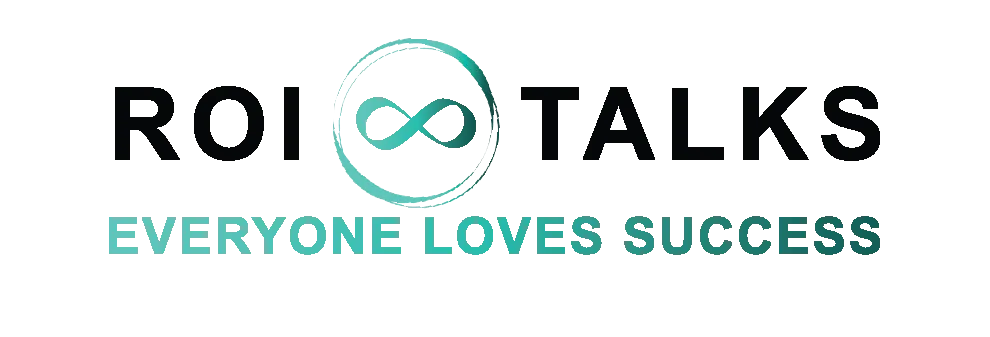Everyone Loves Success
ROI TALKS
Roi Talks Blog

The Power of Nourishing Presentations/ Public Speaking With Ethos, Pathos & Logos
Imagine captivating an audience, leaving them spellbound, and inspiring them to act on your message. Achieving this level of engagement requires more than just delivering content; it demands the masterful integration of rhetorical strategies that foster a nourishing, engaging, and persuasive environment.
Aristotle's timeless rhetorical triangle—ethos, pathos, and logos—provides an essential framework for transforming ordinary presentations into extraordinary experiences.
It provides a foundational framework for effective communication. By incorporating these elements, speakers can establish credibility, evoke emotion, and present logical arguments to persuade and captivate their audience.
Ethos: Establishing Credibility and Trust
Ethos pertains to the speaker's credibility, character, and trustworthiness, which are essential for persuading an audience (Aristotle, 2004). To create a nourishing environment, speakers must establish their expertise, demonstrate honesty, and show concern for the audience's well-being.
Citing Research and Studies: Demonstrating expertise often involves referencing research and studies relevant to the topic. A review of more than 100 persuasion studies by O'Keefe (1990) found that using evidence increases the persuasiveness of an argument. Speakers should ensure that they cite reputable sources, such as academic journals or government reports, to maintain credibility (O'Keefe, 2016).
Personal Experience and Credentials: Sharing personal experiences and relevant credentials can enhance credibility (Hovland, Janis, & Kelley, 1953). For instance, describing professional achievements or showcasing advanced degrees in the field can establish a speaker's authority on the subject matter (McCroskey, 1997).
Relatability and Authenticity: Presenting oneself as genuine and relatable helps build trust with the audience (Cialdini, 2001). This can be achieved through storytelling, disclosing personal information, or sharing anecdotes that reveal vulnerability (Cuddy, Kohut, & Neffinger, 2013). By connecting with the audience on a personal level, speakers can create a nourishing environment conducive to learning and persuasion.
Pathos: Eliciting Emotion and Empathy
Pathos involves appealing to the audience's emotions, values, and desires. Tapping into these emotions can create a nourishing environment that encourages active engagement and enhances the persuasiveness of the message (Green, 2004).
Storytelling and Anecdotes: Stories and anecdotes have been shown to elicit strong emotional responses (Zak, 2014). Incorporating these elements into a presentation can help the audience connect emotionally with the topic, increasing their interest and investment in the content (Green & Brock, 2000).
Emotional Language and Imagery: Using emotionally charged language and imagery can evoke feelings that enhance the persuasive power of a message (Gross, 1998). For instance, a study by Lerner, Small, and Loewenstein (2004) found that participants donated more to a charitable cause when presented with an emotional story about a single individual in need compared to a more analytical, statistics-based appeal.
Empathy and Validation: Acknowledging the audience's emotions, concerns, or experiences can foster empathy and create a supportive atmosphere (Gerber, 2018). By validating their feelings and showing understanding, speakers can encourage a deeper emotional connection and increase the audience's receptivity to their message.
Logos: Structuring Logical Arguments and Presenting Evidence
Logos involves presenting clear, logical arguments supported by evidence. To create a nourishing environment, speakers must ensure that their arguments are well-organized, easy to follow and substantiated by relevant data or facts (Aristotle, 2004).
Clarity and Organization: A well-structured presentation, with clear headings and subheadings, can improve audience comprehension (Alley, 2013). Presenters should provide a roadmap of their talk at the beginning to help the audience follow along and better understand the logical flow of the arguments (Miller, 2011).
Evidence and Data: Providing evidence and data to support claims enhances the persuasiveness of the message (O'Keefe, 1990). Speakers should ensure that their data sources are reliable and should present the information in a clear, digestible format, such as graphs, charts, or infographics (Evergreen, 2016).
Counterarguments and Refutations: Addressing counterarguments and refuting them can strengthen the persuasiveness of the message and demonstrate the speaker's thorough understanding of the topic (O'Keefe, 2016). By anticipating objections and providing well-reasoned rebuttals, presenters can foster an environment of open dialogue and critical thinking.
Integrating & Balancing Ethos, Pathos, and Logos for a Nourishing Presentation
To create a truly nourishing presentation, speakers should strive to balance ethos, pathos, and logos. While each element is essential, overemphasizing one aspect may lead to an imbalance that undermines the overall effectiveness of the message. For example, focusing too heavily on pathos could create an overly emotional atmosphere that obscures logical reasoning (Jasper, 2001). Conversely, relying solely on logos may lead to a dry, unengaging presentation that fails to resonate with the audience on an emotional level (Zillmann, 2002).
Speakers can achieve a balance by employing a variety of rhetorical strategies throughout their presentations. For instance, they might begin with a compelling personal story to establish ethos and evoke pathos, then transition to presenting well-structured arguments supported by data to demonstrate logos. Integrating ethos, pathos, and logos can create a nourishing environment that engages the audience, encourages critical thinking, and enhances the persuasiveness of the message.
In the realm of public speaking, there are few accomplishments more satisfying than crafting a presentation that not only informs but also captivates, motivates, and inspires your audience.
By skillfully incorporating ethos, pathos, and logos, you can create a nourishing environment that leaves your listeners captivated and eager to embrace your message. By establishing credibility, forging emotional connections, and constructing logical arguments, you will elevate your presentation to new heights, fostering a deep sense of engagement and stimulating critical thinking.
As you venture forth to share your ideas, remember to strike a balance among these essential rhetorical elements, weaving them seamlessly into a dynamic and powerful tapestry that will leave your audience inspired and forever changed.
References
Alley, M. (2013). The Craft of Scientific Presentations: Critical Steps to Succeed and Critical Errors to Avoid. Springer Science & Business Media.
Aristotle. (2004). On Rhetoric: A Theory of Civic Discourse (2nd ed., G. A. Kennedy, Trans.). Oxford University Press.
Cialdini, R. B. (2001). Influence: Science and Practice (4th ed.). Allyn & Bacon.
Cuddy, A. J., Kohut, M., & Neffinger, J. (2013). Connect, Then Lead. Harvard Business Review, 91(7-8), 54-61.
Evergreen, S. D. (2016). Effective Data Visualization: The Right Chart for the Right Data. SAGE Publications.
Gerber, M. (2018). Empathy and Connection in Public Speaking. Communication Education, 67(3), 385-388.
Green, M. C. (2004). Transportation into Narrative Worlds: The Role of Prior Knowledge and Perceived Realism. Discourse Processes, 38(2), 247-266.
Green, M. C., & Brock, T. C. (2000). The Role of Transportation in the Persuasiveness of Public Narratives. Journal of Personality and Social Psychology, 79(5), 701-721.
Gross, J. J. (1998). The Emerging Field of Emotion Regulation: An Integrative Review. Review of General Psychology, 2(3), 271-299.
Hovland, C. I., Janis, I. L., & Kelley, H. H. (1953). Communication and Persuasion: Psychological Studies of Opinion Change. Yale University Press.
Jasper, J. D. (2001). Emotions and Social Movements. In J. H. Turner (Ed.), Handbook of Sociological Theory (pp. 611-629). Springer.
Lerner, J. S., Small, D. A., & Loewenstein, G. (2004). Heart Strings and Purse Strings: Carryover Effects of Emotions on Economic Decisions. Psychological Science, 15(5), 337-341.
McCroskey, J. C. (1997). Willingness to Communicate, Communication Apprehension, and Self-Perceived Communication Competence: Conceptualizations and Perspectives. In J. A. Daly, J. C. McCroskey, J. Ayres, T. Hopf, & D. M. Ayres (Eds.), Avoiding Communication: Shyness, Reticence, and Communication Apprehension (2nd ed., pp. 75-108). Hampton Press.
Miller, M. D. (2011). Presentation Skills for Scientists: A Practical Guide. Cambridge University Press.
O'Keefe, D. J. (1990). Persuasion: Theory and Research. SAGE Publications.
O'Keefe, D. J. (2016). Persuasion: Theory and Research (3rd ed.). SAGE Publications.
Zak, P. J. (2014). Why Inspiring Stories Make Us React: The Neuroscience of Narrative. Cerebrum: The Dana Forum on Brain Science, 2.
Zillmann, D. (2002). Exemplification Theory of Media Influence. In J. Bryant & D. Zillmann (Eds.), Media Effects: Advances in Theory and Research (2nd ed., pp. 19-41). Lawrence Erlbaum Associates.
ROI TALKS™
Marina Plaza - Office 1004 -1006
Dubai Marina, Dubai, UAE





